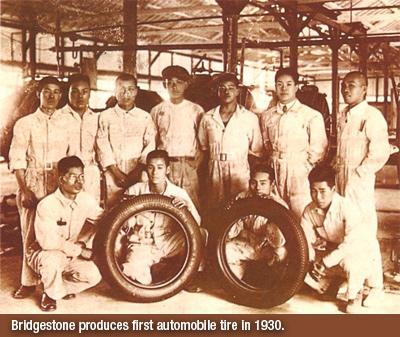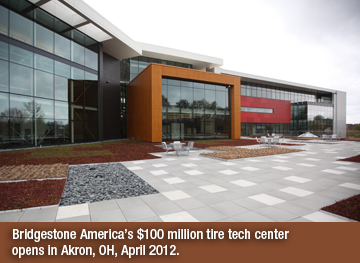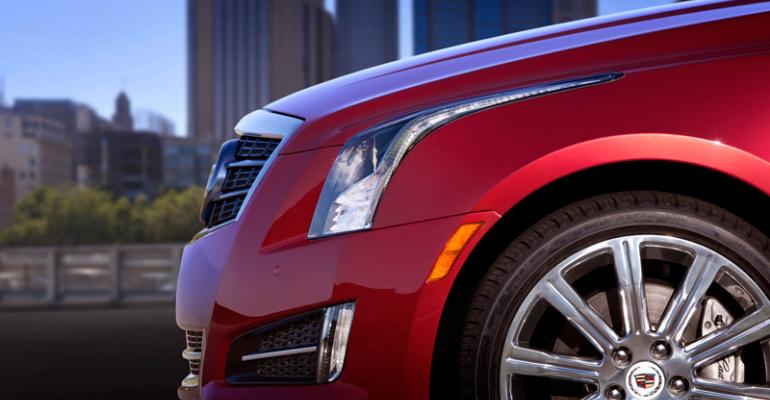TOKYO – Twenty-five years ago this month, Bridgestone took a first step toward becoming a truly global company, and eventually the industry leader, when it surprised the markets by spending $1.2 billion to acquire a controlling stake in the tire operations of Firestone Tire & Rubber.
That decision sparked a series of events that would play out over the decade, profoundly affecting not only the Japanese company but the entire tire industry as well.
On Feb. 18, when Bridgestone reveals its fiscal-2012 revenues, it is expected to still rank as the world’s No.1 tire and rubber company and, for the second-consecutive year, Japan’s most-profitable auto supplier; quite a feat after traveling such a rocky road.
Had the initial Firestone deal gone through smoothly, which it did not, Bridgestone, whose roots trace back to Kurume, a city on Japan’s southernmost island of Kyushu, would have picked up 19 plants including five in North America and six in Europe.
Its bid, made on Feb. 16, 1988, was countered three weeks later by a joint $1.8 billion tender by Michelin and Pirelli for all of Firestone including its North American tire retail chain and lucrative non-tire businesses focusing on synthetic rubber and roofing materials.
Analysts thought the bidding was over and that the French-Italian connection had succeeded in blocking Bridgestone’s entry into the European market and slowing its advance into the Americas.
At the time, Bridgestone, which produced its first automobile tire in 1931, owned a single plant in North America, a medium-size truck-tire facility, and former Firestone factory, in LaVergne, TN, and no plants in Europe.
Surprising the markets again, Bridgestone closed the Firestone deal on March 18, raising the ante to $2.6 billion or $80 a share, up from less than $30 a share in mid-February. The makeup of the tire industry would never be the same, as one by one competitors followed with their own acquisitions and mergers.
First among them were Pirelli and Michelin in 1988. Pirelli bought Armstrong Rubber and Michelin entered into a joint venture with Okamoto Industries.
On the Global Map
In 1989, Michelin bought Uniroyal-Goodrich Tire, and Yokohama Rubber acquired Mohawk Rubber. Nearly a decade later in 1997, Goodyear Tire & Rubber and Sumitomo Rubber Industries completed the industry restructuring by joining forces in North America, Europe and Asia.
Bridgestone all together picked up 27 plants including eight non-tire units and a tire technical center in Europe, raising its global total to 60 facilities, of which 36 were dedicated to tires. Overnight, the company’s market share jumped to 17% from 10% before the acquisition, moving past Goodyear to become the world’s second-largest tire maker behind Michelin.
 Bridgestone, whose name is a transliteration and inversion of the surname of its founder, Shojiro Ishibashi, or “stone bridge,” was on the global map.
Bridgestone, whose name is a transliteration and inversion of the surname of its founder, Shojiro Ishibashi, or “stone bridge,” was on the global map.
“It would have taken decades if we had attempted to establish our own plants in all of these markets – in Europe, North America and Latin America,” Bridgestone CEO Akira Yeiri said in a 1990 interview.
True enough. But along with market share and an overseas presence, Bridgestone also acquired management headaches the likes of which it had never seen. In Yeiri’s words: Bridgestone “swallowed a whale.”
Although Firestone had fewer manufacturing facilities, its labor force was nearly double that of Bridgestone’s, and far less compliant. Added to this, Firestone plants were far less productive, estimated at 50%-60% of Bridgestone’s Japanese plant levels.
Problems arose almost immediately.
Just days before the U.S. Securities & Exchange Commission approved the purchase in early May of 1988, General Motors dropped Firestone as a supplier. GM accounted for a reported 20% of Firestone’s OE business in North America.
Before the year ended, Bridgestone had to put together another mega-financing package, this one for $1.5 billion, to upgrade Firestone plants in North America and Europe. John Nevin, Firestone’s savvy CEO, had refused to let prospective buyers into the plants for a look, thus Bridgestone bought the operation sight unseen.
While all of this was taking place, the U.S. economy went into a deep recession and Firestone’s North American operation began to hemorrhage money.
Over a four-and-a-half-year period through fiscal 1992, losses, mostly in North America, exceeded $1.2 billion, dragging down Bridgestone’s consolidated net earnings to their lowest levels since its 1961 listing on the Tokyo Stock Exchange.
At the low point in fiscal 1989, net earnings fell to ¥4.5 billion ($50 million). Management saved itself the embarrassment of its first deficit by selling off a ¥30 billion ($330 million) tract of land west of Tokyo.
Masatoshi Ono, the former Bridgestone/Firestone chief, reported that losses in its North American operations exceeded $1 million a day in fiscal 1989 and fiscal 1990.
Tire-Recall Debacle
The bleeding finally stopped in 1993, and over the next six years, despite a major labor dispute in the U.S., annual earnings averaged $129 million, rising to $278 million in 1999.
Steven Usher, a respected Tokyo analyst warned that “by running up the price of the acquisition, Michelin and Pirelli bought themselves time while slowing down Bridgestone’s capacity to revamp Firestone’s plants.”
Toward the end of the decade, the U.S. National Highway Traffic Safety Admin. began to take note of the high incidence of serious accidents and upwards of 100 fatalities due to tire failures mostly involving Ford Explorer and Mercury Mountaineer SUVs.
 In May 2000, the watchdog agency contacted Ford and Firestone regarding its concerns. By summer, Bridgestone/Firestone would recall 6.5 million tires and the following May, after nearly a year of finger-pointing and recriminations, the longtime partners would end their century-old business ties.
In May 2000, the watchdog agency contacted Ford and Firestone regarding its concerns. By summer, Bridgestone/Firestone would recall 6.5 million tires and the following May, after nearly a year of finger-pointing and recriminations, the longtime partners would end their century-old business ties.
Bridgestone refused to disclose its losses from the recall. However, management set aside $.8 billion in contingency funds in fiscal 2000 and fiscal 2001.
A decade after the recall, Bridgestone ranks as the world’s No.1 tire manufacturer with an estimated 15% global share, down slightly along with other traditional brands due to the emergence of new manufacturers, particularly in China and India.
Bridgestone also stands as Japan’s most-profitable automotive supplier, having passed Denso in fiscal 2011. When the tire maker announces its fiscal 2012 results on Feb. 18, management expects operating income and margins to reach a record ¥287 billion ($3.2 billion) and 9.2%, respectively.
Bridgestone has achieved these levels in the face of a record-strong yen in fiscal 2012.
By the end of the current fiscal year, the company will operate 51 tire plants including three new facilities under construction in Thailand, Vietnam and the U.S. Bridgestone’s newest factory, in Pune, India, came on stream in January. Production outside Japan will approach 75%, up from an estimated 20% in fiscal 1987.
The company still operates 10 plants in Japan, including the mother Kyushu plant. Counting industrial and diversified products, Bridgestone operates 179 plants globally.
Under Bridgestone’s midterm business plan, management aims to achieve a 10% operating profit margin and 5% growth in yearly sales between fiscal 2013 and fiscal 2017, slightly ahead of the industry’s projected pace of 3%.
 Bridgestone Global Tire Plants
Bridgestone Global Tire Plants
NORTH AMERICA
1) Joliette, QC (Canada)*
2) Cuernavaca (Mexico)*
3) Monterrey (Mexico)
4) Russellville, AR (U.S.)
5) Bloomington, IL (U.S.)
6) Des Moines, IA (U.S.)*
7) Wilson, NC (U.S.)*
8) Aiken, SC (U.S.)
9) LaVergne, TN (U.S.)*
10) Warren, TN (U.S.)
SOUTH AMERICA
11) Buenos Aires (Argentina)*
12) Bahia (Brazil)
13) Sao Paulo (Brazil)*
14) San Jose (Costa Rica)*
15) Valencia (Venezuela)*
EUROPE
16) Bethune (France)*
17) Tatabanya (Hungary)
18) Bari (Italy)*
19) Poznan (Poland)
20) Stargard (Poland)
21) Bilbao (Spain)*
22) Puente San Miguel (Spain)*
23) Burgos (Spain)*
MIDDLE EAST & AFRICA
24) Izmut (Turkey)
25) Brits (South Africa)*
26) Port Elizabeth (South Africa)*
ASIA
27) Huizhou (China)
28) Shenyang (China)
29) Tianjin (China)
30) Wuxi (China)
31) Indore (India)
32) Pune (India)
33) Bekasi (Indonesia)
34) Karawang (Indonesia)
35) Hsin-Chu (Taiwan)
36) Chonburi (Thailand)
37) Nong Khae (Thailand)
38) Rangsit (Thailand)
JAPAN
39) Amagi (Fukuoka)
40) Hikone (Shiga)
41) Hofu (Yamaguchi)
42) Kitakyushu (Fukuoka)
43) Kodaira (Tokyo)
44) Kurume (Fukuoka)
45) Nasushiobara-1 (Tochigi)
46) Nasushiobara-2 (Tochigi)
47) Shimonseki (Yamaguchi)
48) Tosu (Saga)
* Plants purchased from Firestone including the LaVergne, TN, plant that Bridgestone bought in 1983, five years before the acquisition. Of the 19 plants Bridgestone added in 1988, it subsequently closed the Decatur, IL, and Oklahoma City, OK, facilities in the U.S., and others in Mexico City and Alcoehete, Portugal.





